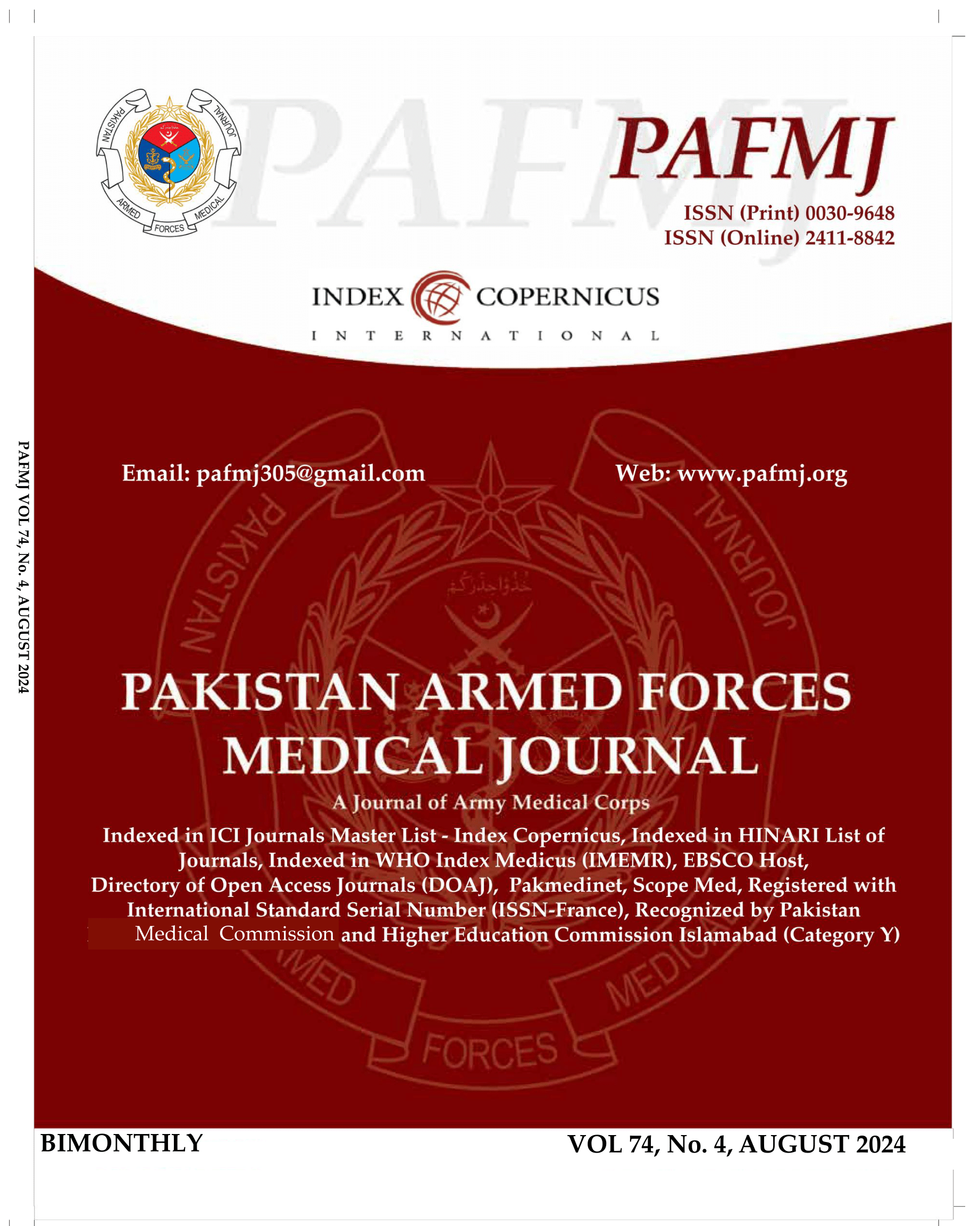Gender-Based Differences in the Outcome of Laparoscopic Cholecystectomy in Patients with Gall Stones
DOI:
https://doi.org/10.51253/pafmj.v74i4.9627Keywords:
Cholecystectomy, Cholecystitis, LaparoscopicAbstract
Objective: To determine the outcome of laparoscopic cholecystectomy in males versus females.
Study Design: Cross-sectional analytical study.
Place and Duration of Study: Department of General Surgery, Combined Military Hospital Rawalpindi Pakistan, from Mar to Aug 2022.
Methodology: A total of 200 participants were enrolled in the study as Group–A (Males) and Group – B (Females). Patients were selected based on inclusion and exclusion criteria and variables analyzed were demographic profile, past abdominal surgery history, total duration of surgery computed from the insertion of the telescopic port till the extraction of the gall bladder, post-operative hospitalization in terms of the number of days, event of laparoscopic cholecystectomies to open cholecystectomies along with the reasoning of this decision, and perioperative/postoperative complications.
Results: A total of (200) elective laparoscopic cholecystectomies cases were included in the study with 35(17.5%) males (Group-A) and 165(82.5%) females (Group-B). A relatively higher frequency of 46(27.9%) (p-value 0.01) of lower abdominal surgeries were recorded in female participants. No statistically significant difference in duration of surgery was recorded (p-value 0.9). The thin-walled gallbladder was mainly represented by the female candidates 105(63.6%). Laparoscopic cholecystectomies was converted to open cholecystectomies in 2(1.2%) females however it was not encountered in any of the male participants (p-value 0.51).
Conclusion: Gender-based frequency of cholecystitis and laparoscopic cholecystectomies is greater in females as compared to males with a ratio of 4.7:1 with no significant difference in the preoperative, intraoperative, and postoperative outcomes between the genders.
Downloads
References
Coelho JCU, Dalledone GO, Schiel W, Berbardin JP, Claus CMP, Matias JEF, et al. Does male gender increase the risk of laparoscopic cholecystectomy? Arq Bras Cir Dig 2019; 32(2): e1438.
https://doi.org/10.1590/0102-672020190001e1438
Vaccari S, Cervellera M, Lauro A, Palazzini G, Cirocchi R, Gjata A, et al. Laparoscopic cholecystectomy: which predicting factors of conversion? Two Italian center's studies. Minerva Chir 2020; 75(3): 141-152.
https://doi.org/10.23736/s0026-4733.20.08228-0
Rice CP, Vaishnavi KB, Chao C, Jupiter D, Schaeffer AB, Jenson WR, et al. Operative complications and economic outcomes of cholecystectomy for acute cholecystitis. World J Gastroenterol 2019; 25(48): 6916.
https://doi.org/10.3748%2Fwjg.v25.i48.6916
Macedo FI, Eid JJ, Mittal VK, Flynn J, Jacobs MJ, Pearlman R, et al. Impact of medical or surgical admission on outcomes of patients with acute cholecystitis. HPB 2017; 19(2): 99-103.
https://doi.org/10.1016/j.hpb.2016.11.007
Chen G, Li M, Cao B, Xu Q, Zhang Z. Risk prediction models for difficult cholecystectomy. Videosurg Other Miniinvasive Tech 2022; 17(2): 303-308.
https://doi.org/10.5114/wiitm.2022.114539
Thiels CA, Yu D, Abdelrahman AM, Habermann EB, Hallbeck S, Pasupathy KS, et al. The use of patient factors to improve the prediction of operative duration using laparoscopic cholecystectomy. Surg Endosc 2017; 31(1): 333-340.
https://doi.org/10.1007/s00464-016-4976-9
Kumar J, Kumar P, Meena K, Siddiqui AA. Male gender as an independent risk factor for laparoscopic cholecystectomy: An outcome analysis at a teaching institute. Saudi J Health Sci 2017; 6(2): 104-109.
https://doi.org/10.4103/sjhs.sjhs_65_17
Lu P, Yang NP, Chang NT, Lai KR, Lin KB, Chan CL. et al. Effect of socioeconomic inequalities on cholecystectomy outcomes: a 10-year population-based analysis. Int J Equity Health 2018; 17(1): 1-10. https://doi.org/10.1186/s12939-018-0739-7
Chae KL, Park SY, Hong JI, Yim WJ, Lee SC, Chung CJ. The effect of gender and age on postoperative pain in laparoscopic cholecystectomy: a prospective observational study. Anesth Pain Med 2019; 14(3): 364-369.
https://doi.org/10.17085/apm.2019.14.3.364
Bahadur A, Bisht SD, Rathi Y, Shukla A, Aggarwal A. Is gender a determinant for the outcome of laparoscopic cholecystectomy? Int Surg J 2020; 7(12): 3959-3964.
https://doi.org/10.18203/2349-2902.isj20204992
Naseem AC, Fateh DK, Muhammad IB, Muhammad HL. Surgical incidence of cholelithiasis in Hyderabad and adjoining areas (Pakistan). Pak J Med Sci 2004; 20: 13-17.
Ekici U, Tatlı F, Kanlıöz M. Preoperative and postoperative risk factors in laparoscopic cholecystectomy converted to open surgery. Adv Clin Exp Med 2019; 28(7): 857-860.
https:doi.org/10.17219/acem/81519
Oymaci E, Ucar AD, Aydogan S, Sari E, Erkan N, Yildirim M. Evaluation of affecting factors for conversion to open cholecystectomy in acute cholecystitis. Prz Gastroenterol 2014; 9(6): 336–341. https://doi.org/10.5114/pg.2014.45491
Ghadhban BR. Assessment of the difficulties in laparoscopic cholecystectomy among patients at Baghdad province. Ann Med Surg 2019; 41: 16-19. https://doi.org/10.1016/j.amsu.2019.03.008
Al-Naser MK. Port Site Infections after laparoscopic cholecystectomy. Int J Med Health Res 2017; 6(6): 132-137.
Ekici U, Yılmaz S, Tatlı F. Comparative analysis of laparoscopic cholecystectomy performed in the elderly and younger patients: should we abstain from laparoscopic cholecystectomy in the elderly? Cureus 2018; 10(6): 2888.
https://doi.org/10.7759/cureus.2888
Inoue K, Ueno T, Douchi D, Shima K, Goto S, Takahashi M, et al. Risk factors for difficulty of laparoscopic cholecystectomy in grade II acute cholecystitis according to the Tokyo guidelines 2013. BMC Surg 2017; 17(1): 1-8.
https://doi.org/10.1186/s12893-017-0319-6
Ambur V, Taghavi S, Kadakia S, Jayarajan S, Gaughan J, Sjoholm LO, et al. Does socioeconomic status predict outcomes after cholecystectomy? Am J Surg 2017; 213(1): 100-104.
https://doi.org/10.1016/j.amjsurg.2016.04.012
Grace HE, Kamel RR, Rafik H, El-Sattar A. A prospective study of the incidence of conversion of laparoscopic cholecystectomy to open cholecystectomy in 100 patients. Ain Shams Med J 2021; 72(2): 267-278. https://dx.doi.org/10.21608/asmj.2021.192517
Mansour LT, Brien S, Reid J, Maddern GJ. Peri-operative mortality following cholecystectomy in Australia: potential preventability of adverse events. World J Surg 2021; 45(3): 681-689. https://doi.org/10.1007/s00268-020-05815-5
Qazi M, Shah RU, Shah S, Shiraz DA, Ullah HN. Outcome of laparoscopic cholecystectomy in terms of complications in Lady Reading Hospital Peshawar. Professional Med J 2022; 29(06): 859-863. https://doi.org/10.29309/TPMJ/2022.29.06.6639
Downloads
Published
Issue
Section
License
Copyright (c) 2024 Sohaib Ashraf, Muhammad Shoaib Khan, Nasir Mehmood Wattoo, Abdur Rehman Rashid, Shakeel Ahmed Zia

This work is licensed under a Creative Commons Attribution-NonCommercial 4.0 International License.















